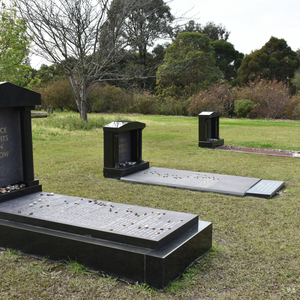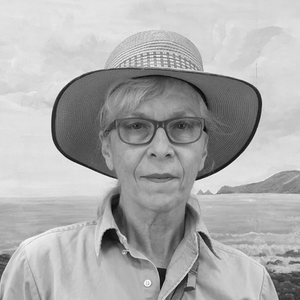 WINNER - Elite Funeral Directors Award
WINNER - Elite Funeral Directors Award
May their memory be a blessing (2022)
Printed adhesive vinyl, stones and Rookwood training graves

The ghosts of murdered family are part of our childhoods. We confront this past to name those who died, to acknowledge that they lived, loved, mattered. As no graves exist, naming family allows us to honour and commemorate them. Placing pebbles is an act of remembrance and signals visitation.
This memorial artwork was conceived with my cousin Dorit Braun and is based on her research of family who perished in the Holocaust and the extensive research of Alisa Sharon into our family tree.
Other friends with shared histories have been invited to contribute their family names to this artwork. As the second generation of survivors who established new lives in Australia, we carry our parents’ trauma and grief. May their memory also be a blessing.
About the Artists
 Anne Zahalka lives on Gadigal Country in Sydney’s inner west. She is a photo-media artist whose work explores issues of identity, belonging, memory and place. With a migrant background, Zahalka constructs new narratives that reflect on diversity, gender, and difference within Australian society.
Anne Zahalka lives on Gadigal Country in Sydney’s inner west. She is a photo-media artist whose work explores issues of identity, belonging, memory and place. With a migrant background, Zahalka constructs new narratives that reflect on diversity, gender, and difference within Australian society.
The artist would like to thank: Vivien and Dennis Altman, Jane Becker, Ella Dreyfus, Juno Gemes, Su Goldfish, Jeanie Kable (née Zahalka), Julie Robb, Monica Robinson, Alisa and Thommy Sharon, Sue and Sandy Saxon, Leslie Solar, Naomi and Anita Ullmann; who contributed to this work in commemoration of their families.
Transcription
My name is Anne Zahalka and I live in Newtown on Gadigal land.
May their memory be a blessing is a traditional Jewish expression said for the dead, to comfort the bereaved and to honour the memory of those they mourn. I have used this honorific as the title of the work to speak of Jewish families lost in the Holocaust.
The artwork consists of a list of names that have been inscribed on Granite Training Graves that provide a ready made site for the transmission of this memorial artwork. They are normally used by symmetry workers to practice burials on, but without the remains. Each grave has a traditional shaped headstone and one has a footstone. Small pebbles have been placed beside each name, which is a Jewish custom to signal visitation and a sign of remembrance. One of the graves holds only pebbles that have been laid out in a ribbon formation. For All the many other families who remain unnamed. Grass has been left to grow around the grave, creating a soft bed for the family names to rest. Each of the grave headstones was graphically designed and has been hand painted in gold lettering with a dedication drawn from inspirational texts. The headstone texts were developed to evoke thoughts of absence, loss, memory and remembrance. The artwork was originally conceived with my cousin, Dorit Braun, who lives in London and who had undertaken research into our family ancestry, uncovering a daunting list of relatives who were murdered in the Holocaust.
We wanted to honor our family through the making of this memorial artwork and felt an enormous on responsibility to bring these names to light and do justice to them, to acknowledge that they lived, loved and mattered. Compiling the list of names required considerable research and care, with the confronting details of their deaths. As often no death certificate existed. We have relied on Holocaust and memorial records, family memoirs and documents to provide the date, age and place of death, if known. Once this information was compiled, we decided to handwrite the names on the granite stone, which had a simplicity and directness, giving a more personal connection with the work and the people we were naming. It felt more meaningful somehow.
I wanted to share this opportunity of naming family with other second generation of survivors who had grown up here in Australia without grandparents, aunts or uncle's. As no graves of burial grounds exist for these relatives, it provided a place to acknowledge them and to confront this loss together and to share our sorrow. Ten contributors who have been acknowledged in the catalogue have joined me. We held a small service together to lay the stones and say the Kaddish, a Jewish memorial prayer that is said for the dead.
Because this is a memorial artwork, Rookwood cemetery provides a sympathetic and reflective environment to commemorate these families who were taken from us. Cemeteries are places to remember loved ones and for ritual observance and respect for those of us without. This special site HIDDEN has provided it. We want to feel a shared sense of humanity in recognition of our loss and love and hope. It encourages visitors to reflect on the impact the Holocaust continues to have on generations that followed. It reminds us of the fragility of life and the importance of tolerance and inclusivity in the memory of our beloved Jewish families and for the respect of all cultures and people.